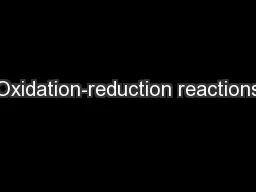

Oxidation and reduction Oxidation and reduction oxygen transer A substance has been oxidised if it gains oxygen Oxidation is gain of oxygen A substance has been reduced if it ID: 618254
Download Presentation The PPT/PDF document "Oxidation-reduction reactions" is the property of its rightful owner. Permission is granted to download and print the materials on this web site for personal, non-commercial use only, and to display it on your personal computer provided you do not modify the materials and that you retain all copyright notices contained in the materials. By downloading content from our website, you accept the terms of this agreement.
Slide1
Oxidation-reduction reactionsSlide2
Oxidation and reduction
Oxidation and reduction – oxygen
transer
A substance has been oxidised if it gains oxygen. Oxidation is gain of oxygen.A substance has been reduced if it loses oxygen. Reduction is loss of oxygen.Slide3
Redox
Reactions
A redox reaction is one in which both reduction and oxidation are occurring.
Oxidation
and
reduction always go hand-in-hand.Slide4
Reducing & Oxidising Agents
A
reducing agent
is a substance that reduces something else. In this case the magnesium is the reducing agent
.
An
oxidising agent is a substance that oxidises something else. The
copper(II) oxide is the oxidising agent
in this reaction.Slide5
Hydrogen Peroxide (H2
O
2
)Hydrogen peroxide is unusual. It can act as both an oxidising agent
and as a
reducing agent
.Example 1: H
2
O
2
as an oxidising agent
PbS
+ 4H2O2 → PbSO4+ 4H2OExample 1: H2O2 as a reducing agent2MnO4- + 5H2O2 + 6H+ → 2Mn2++ 8H2O + 5O2Slide6
Oxidation and reduction
Oxidation and reduction – electron transfer
O
xidation Is Loss of electronsReduction Is Gain of electons(Remember:
OIL
RIG
)Slide7
Oxidation and reduction – electron transferSlide8
Oxidation Numbers
Example 1
Determine the oxidation number of
S in SO2S + 2(O) = 0S + 2(-2) = 0S + (-4) = 0S – 4 = 0S = +4
Therefore the oxidation number of
S = +4
The compound SO
2
can be called
sulphur(IV) oxide
because of the
oxidatioin
state of the sulphur in the compound.Slide9
Example 2Determine the oxidation number of
N
in NO3-N + 3(O) = -1N +
3(-
2) =
-1N +
(-
6
)
=
-1
N – 6 = -1N = -1 + 6 = +5Therefore the oxidation number of N = +5The name of this ion is the nitrate(V) ion because of the oxidation state of nitrogen in the ion.Slide10
Example 3Determine the oxidation number of C in H
2
CO
32(H) + 1(C) + 3(O) = 02(+1) + 1(C) + 3(-2) = 0+2 + C + (-6) = 0+2 + C - 6 = 0C =
+6
- 2
C = +4Therefore the oxidation number of
C = +4Slide11
Example 4Determine the oxidation number of
Mn
in MnO4-1(Mn) + 4(O) = -1Mn
+
4(-2) = -1
Mn +
(-8)
=
-1
Mn
- 8
= -1Mn = -1 + 8Mn = +7Therefore the oxidation number of Mn = +7The name of this ion is the manganate(VII) ion because of the oxidation state of manganese in this ion.Slide12
Example 5Determine the oxidation number of
Cr
in K2Cr2O72(K) + 2(Cr) + 7(O) = 0
2(+1)
+ 2(Cr) + 7
(-2) = 0+2 + 2Cr +
(-14)
= 0
+2 + 2Cr – 14 = 0
2Cr = +14 – 2 = +12
Cr =
+6Therefore the oxidation number of Cr = +6The name of this compound is potassium dichromate(VI) because of the oxidation state of the chromium.Slide13
Example 6Determine the oxidation number of
P
in Mg3(PO4)23(Mg) + 2(P) + 8(O) = 0
3(+2)
+
2(P) + 8(-2) = 0
+6
+
2P
+
(-16)
= 0+6 + 2P – 16 = 02P = +16 – 6 = +10P = +5Therefore the oxidation number of P = +5Slide14
Example
Reaction between magnesium and copper(II) oxide
Mg
(s) + CuO(s) → MgO(s) + Cu(s)Ionic Equation:
Mg
(s)
+ Cu2+(s) + O
2-
(s)
→
Mg
2+(s) + O2-(s) + Cu(s)Removing spectator ions, we get:Mg(s) + Cu2+(s) → Mg2+(s) + Cu(s)The ionic equation shows that the reaction has nothing to do with oxygen.Slide15
What is actually happening is that magnesium atoms are turning into magnesium ions
.
The magnesium
atoms lose electrons to form magnesium ions.Mg(s) → Mg2+(s)+ 2e
-
(Mg is
oxidised)
Those
electrons have been gained
by the copper(II)
ions
to make the
atoms present in metallic copper.Cu2+(s)+ 2e- → Cu(s) (Cu2+ is reduced)(Remember: OILRIG)Slide16Slide17
Using hydrogen as a reducing agent
The reduction of copper(II) oxide to copper
Copper
won’t react with water because copper is below hydrogen in the Reactivity Series, but that means that you can get a reaction between hydrogen and copper(II) oxide.
The hydrogen removes the oxygen from the copper(II) oxide, so that hydrogen is a reducing agent.Slide18
Experiment
Hydrogen is passed over hot copper(II) oxide. The oxide glows
red hot
and continues glowing, even if you remove the Bunsen burner. Lots of heat is released during the reaction.Colourless liquid – waterPinky brown solid – copperSmall flame at end – excess hydrogen being burned offSlide19
Displacement reactions involving solutions of salts
The reaction between zinc and copper(II) sulphate solution
Zn
(s) + CuSO4(aq) → ZnSO4(aq) + Cu
(s)
Ionic Equation:
Zn(s)
+ Cu
2
+
(
aq
) + SO42-(aq) →Zn2+(aq) + SO42-(aq) + Cu(s)Removing Spectator Ions:Zn(s) + Cu2+(aq) →Zn2+(aq) +
Cu
(s
)
This is a
redox reaction
.Slide20
The reaction between zinc and copper(II) sulphate solutionSlide21
The reaction between copper and silver nitrate solution
Cu
(s
) + 2AgNO3(aq) → Cu(NO3)2(aq
)
+
2Ag(s)
Ionic Equation:
Cu
(s
)
+
2Ag+(s) + 2NO3-(aq) →Cu2+(aq) + 2NO3-(aq) + 2Ag(s)Removing Spectator Ions:Cu(s) + 2Ag+(s) → Cu2+
(
aq
)
+
2Ag
(s
)
This is a
redox reaction
.Slide22
The reaction between copper and silver nitrate solution